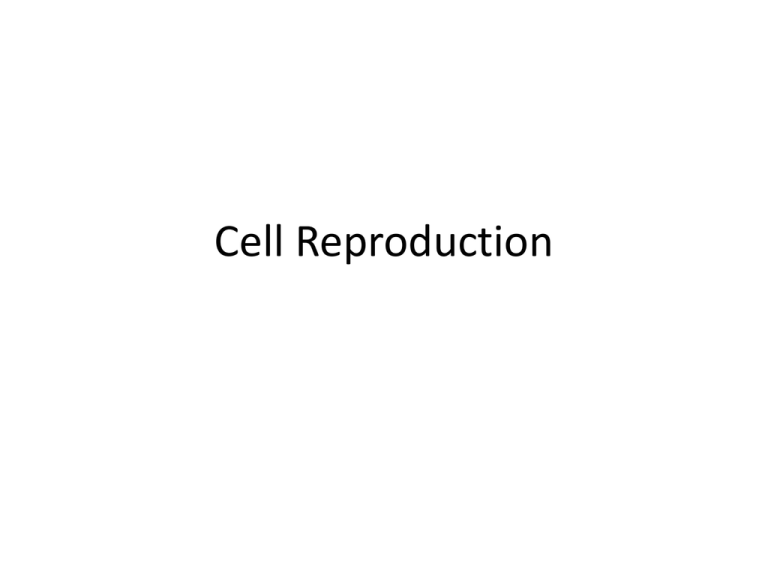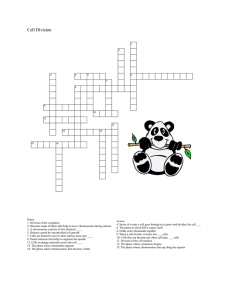Messenger RNA - Maria Regina
advertisement

Cell Reproduction Cell Division • Increases the number of cells and causes many-celled organisms to grow • Cell cycle- series of events that take place from one cell division to the next Interphase • Most of the life of a eukaryotic cell, or cell with a nucleus, is spent in this period of growth and development – During interphase, a cell duplicates its chromosomes and prepares for cell division – After interphase, the nucleus divides, and then the cytoplasm separates to form two new cells • Muscle and nerve cells no longer divide so they are always in interphase Chromosomes • Chromosome- structure in the nucleus that contains hereditary material Mitosis • Process in which the nucleus divides to form two identical nuclei Prophase • Nucleolus and nuclear membrane disintegrate • Centrioles move to the opposite ends of the cell • Spindle fibers begin to stretch across the cell Metaphase • Pairs of chromatids line up across center of cell Anaphase • Each centromere divides • Each pair of chromatids separates and moves to opposite ends of the cell Telophase • Spindle fibers disappear and a new nucleus forms Cytokinesis • For most cells, the cytoplasm separates after the nucleus divides – In animal cells, the cell membrane pinches in the middle and the cell membrane divides – In plant cells, a cell plate forms Results • Each cell in your body, except for sex cells, has a nucleus with 46 chromosomes – People with conditions such as Down Syndrome, have extra or less chromosomes. • Allows growth and replaces worn out or damaged cells Asexual Reproduction • A new organism is produced from one parent organism – An organism with no nucleus divides into two identical organisms by fission – Budding a small exact copy of the adult grows from the body of the parent – Regeneration a whole new organism grows from a piece of the parent Sexual Reproduction • Two sex cells, called the sperm and egg, come together – Sperm formed in male reproductive organs – Egg formed in female reproductive organs • Fertilization the joining of the sperm and egg – The new cell that forms after fertilization is called the zygote. Cells • Your body forms 2 types of cells – Diploid cells that have 23 pairs of chromosomes. Includes brain, skin, bone cells. – Haploid only 23 individual chromosomes, NOT PAIRS. These are the sperm and egg cells. Meiosis • Process that produces haploid cells. • Insures that offspring will have same total amount of chromosomes as parent because after two haploid cells combine, a diploid zygote is produced • During meiosis, two nucleus divisions occur – Meiosis I – Meiosis II Interphase • Before meiosis starts, each chromosome is duplicated (just like in mitosis) Prophase I • Nucleolus and nuclear membrane disintegrate • Centrioles move to the opposite ends of the cell • Spindle fibers begin to stretch across the cell • Each duplicated chromosome comes near its duplicate Metaphase I • Pairs of duplicated chromosomes line up in center of cell • The centromere of each chromatid pair attaches to a spindle fiber Anaphase I • Two pairs of chromatids of each similar pair move away from each other to opposite ends of the cell. • Each duplicated chromosome still has two chromatids. Telophase I • Cytoplasm divides and two new cells form • Each new cell has one duplicated chromosome from each similar pair Prophase II • The duplicated chromosomes and spindle fibers reappear in each cell Metaphase II • Duplicated chromosomes move to the center of the cell • Each centromere attached to two spindle fibers instead of one Anaphase II • Centromere divides • Chromatids separate and move to opposite sides of the cell • Each chromatid is individual chromosome Telophase II • Spindle fibers disappear. • New nuclear membrane forms around each set of chromosomes at each end of the cell Meiosis • At the end of meiosis II, the cytoplasm divides. • SUMMARY – Two cells form during meiosis I – Those two cells form two new cells in meiosis II – Results in FOUR SEX CELLS, each with one half the number of chromosomes in its nucleus as in the original nucleus Let’s Review Meiosis! DNA • Deoxyribonucleic acid (a chemical) • Contains information for organism’s growth and function • When a cell divides, DNA code is copied and passed to new cell • Watson and Crick made accurate model of DNA in 1953 DNA Structure • Similar to twisted ladder • Sides of ladder are made up of sugar-phosphate molecules • The rungs of ladder made of nitrogen bases – Adenine and Thymine are base pairs – Guanine and Cytosine are base pairs • Before cell divides, DNA duplicates itself by unwinding and separating its sides, then each side becomes a pattern on which new side forms Genes and RNA • Genes sections of DNA on a chromosome • RNA carries the codes for making proteins from the nucleus to the ribosomes in the cytoplasm – Messenger RNA carries the code that directs the order in which amino acids bond – Ribosomal RNA makes up ribosomes, where proteins are built – Transfer RNA brings amino acids to the ribosomes to build proteins Codons • Every 3 base pairs (such as UGA) on the messenger RNA are a CODON • Each codon represents a specific amino acid • The ribosome reads the messenger RNA by each codon, then adds the correct amino acid to the protein chain RNA RNA • DNA vs. RNA • DNA to RNA to Proteins Mutations • Any permanent change in the DNA sequence of a cell’s genes or chromosome – Can be caused by outside factors like X rays, sunlight, and chemicals – A change in the gene or chromosome can change traits of the organism






